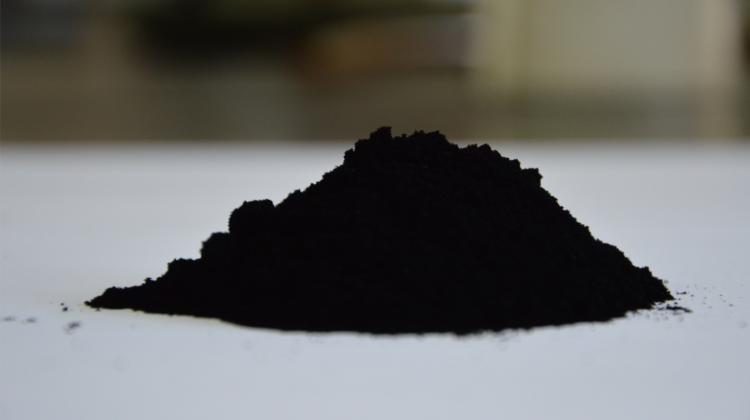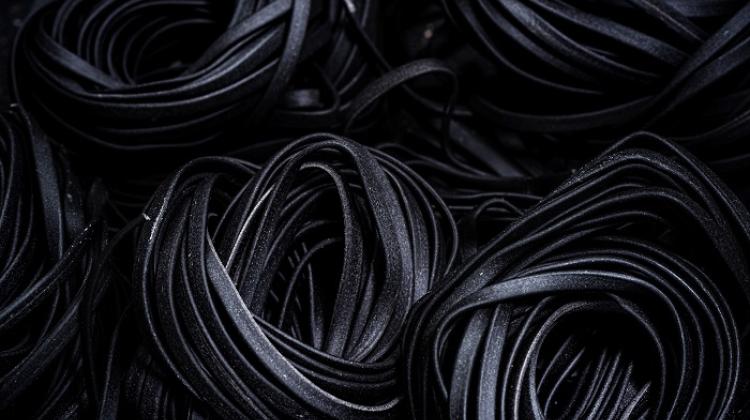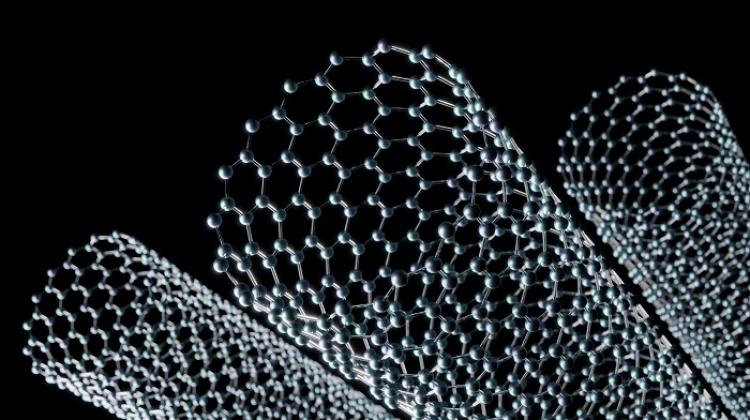Cinderella 2.0 picks out nanotubes from black dust
 Photo by Dawid Janas, Silesian University of Technology
Photo by Dawid Janas, Silesian University of Technology
Polish researchers solved the problem of researchers working with carbon nanomaterials in laboratories around the world. They used a method developed over 150 years ago. They can separate the selected type of nanotubes from the crowd of others, whose diameters differ from each other by the length of the radius of the hydrogen atom. The idea has been described in Nature Scientific Report.
Dr. Dawid Janas, a chemist from the Silesian University of Technology, has developed a method - faster and cheaper than those previously used - to select nanotubes with specific properties for research. In a Science in Poland interview, he explains why such selection has been problematic, why nanotubes get mixed and what these tiny graphene tubes can be used for.
"A nanotube is built of carbon and it is empty inside. It is created by folding a graphene sheet, like a paper sheet, into a tiny roll. The problem is that such a sheet can be rolled up in many different ways and at different angles. And then the nanotubes have radically different properties" - the researcher says.
CINDERELLA WOULD NOT MAKE IT TO THE BALL
When scientists synthesize or "produce" nanotubes in their furnaces, they receive 30 to 50 types of nanotubes in one material. The nanotubes are tiny, their diameter is one hundred thousand times smaller than the human hair. And it is impossible to control production to obtain identical nanotubes. At best, a small amount of this material, this black powder, can be produced so that half has the given parameters. That is not enough. They have to be divided.
"Seen with the naked eye, nanotubes look like black flour - compares the researcher from the Silesian University of Technology. - Imagine that we mixed different flours together, and there are at least 20 types. We mix them in different proportions - nanotubes are formed in a similar manner. It`s impossible to bake anything with this mixture of several types of flour. That is also the situation here. Therefore, researchers are looking for methods to divide these nanotubes into individual types".
Dr. Janas explains that separating nanotubes is difficult, because the black powder is homogeneous and you can not extract the desired nanotubes with nano-tongs. Nor - the scientist jokes - order students to separate them in their free time, instead of, say, going to a club, like Cinderella picking out lentils from and ash.
FROM TRANSISTORS TO TUMOUR IMAGING
Specific types of nanotubes can be useful in many practical applications and are essential in basic research. Dr. Janas gives examples of some of the properties that researchers may be looking for.
"There are metallic nanotubes that conduct electricity better than copper. Another type of semiconductor nanotubes is desirable for the construction of transistors. Thus, a researcher who wants to build a transistor with certain parameters must select semiconductor nanotubes with a specific method of rolling. Even a subtle difference in the way it rolls up results in different properties of individual nanotubes" - the researcher says.
Scientists from the United States are analysing another promising, though - as the scientist points out - controversial use of nanotubes. It is related to their optical properties. If you divide nanotubes into different types, they will have different colours - purple, yellow, green - although they are built of carbon. As a result, they can be used to image the processes occurring in a living organism. Selected types of carbon nanotubes in a solution are ideal contrasts for organ imaging.
"In a study conducted at a clinic in New York, solutions of nanotubes are injected into the blood of rats, which allows us to assess the disease and the functioning of the body. On the one hand, introduction of nanoparticles into a living organism can be frightening. On the other hand, not only a much smaller concentration is required to image the interior of an organ, research has also shown that it is less toxic than the currently used substances. In cancer clinics, there are no solutions that are good for imaging all tumours. In this case, anything new is a salvation for patients. In addition, it is possible to target nanotubes for very sensitive imaging of a given location" - says Dr. Janas.
So how do you pick out the desired nanotubes from the "black powder"?
THE POLISH METHOD IS FASTER AND ALMOST HOME-MADE
Previous nanotube dividing methods required very expensive equipment - centrifuges or electrical devices capable of capturing minimal differences in the size of the nanotubes and the ways they roll up. Chemical reagents are also expensive, and the separation process must be done in many steps, in several stages. This shows how difficult it would be to use in industry. In addition, Dr. Janas` experience is that these are not efficient methods, because in subsequent steps there is very little target material left.
"Our idea is based on the method from 1885, developed by a Dutch scholar, Martinus Beijerinck. When he mixed two aqueous solutions (of agar and gelatin), he was very surprised that they formed two separate phases. Similarly, if you pour oil on water, they separate from each other. The method has since been developed by molecular biologists, enzymes and proteins are obtained in this way. It is also used in pharmaceutical industry for the purification of medicinal substances" - the researcher says.
This ability to create two layers in a solution (the so-called two-phase system) can be used to divide carbon nanotubes. Appropriate reagents added to such a system cause that half of the nanotubes to "go" up and the other half - down. Later, in the next step, they divide evenly in the bottom and top, and after a few steps you can obtain the selected type.
Dr. Janas and members of his research group wanted to optimise this multi-stage process. Their goal was to learn to select nanotubes in one step. That is - instead of dividing into halves - make them all go up, and only one selected group - down. They wanted to simplify it as much as possible to be able to do this experiment in a "home kitchen".
Researchers from Silesia determined that the lower phase should be an aqueous solution of dextran (a compound of sugars) and the top one should be a poly(ethylene glycol). Dr. Janas decided to introduce one more chemical compound, which affects the migration of nanotubes in the solution. He wanted to force the selected type of nanotubes to choose a specific phase, and the rest to abandon this loner.
STINKING KEY TO SUCCESS
"It turned out that the key compound was ammonia. Or hydrazine, whose molecule is like two connected ammonia molecules. We added a delicate amount of 75 microliters of ammonia and we learned to control the division. With the appropriate concentration of ammonia, we can select a given type of nanotubes from this group in one step. All the others are going up, and we can select our desired type" - declares the researcher.
Polish scientists can select different types of nanotubes, even those in the minority. They effectively managed to obtain even the type that represented only 6 percent of the whole mixture.
"This system is so precise that it allows you to separate nanotubes whose diameters differ only by one-tenth of a nanometer - this is actually the radius of a hydrogen atom! Such a small difference! It turns out that the appropriate selection of the complex reagent system allows us to work so precisely that our desired type of nanotubes is found in only one phase" - says the main author of the publication in Nature Scientific Report.
Dr. Janas imagines that since it is possible to increase the precision of division in the case of carbon nanotubes so much, this system could also allow for precise purification of medicines - saving a few steps, which translates into lower costs. This is one of the possible future developments of this technology.
The original method of chemists from the Silesian University of Technology met with the interest of scientists from Japan, China and the United States. Dr. Janas has teamed up with the Los Alamos National Laboratory in the USA, which studies the optical properties of nanotubes. The researchers at Los Alamos have high hopes for improving the nanotubes selection procedure. They hope that it will open the possibility of understanding the nano world faster and easier, since only 5 chemical compounds and a blender are required.
Dr. Janas confirmed his research on the world`s best equipment for testing nanotubes during last year`s fellowship in Japan. For now, the Polish know-how is useful in basic research.
The publication i available at: https://www.nature.com/articles/s41598-018-37675-4
PAP - Science in Poland, Karolina Duszczyk
kol/ ekr/ kap/
tr. RL
Przed dodaniem komentarza prosimy o zapoznanie z Regulaminem forum serwisu Nauka w Polsce.


















